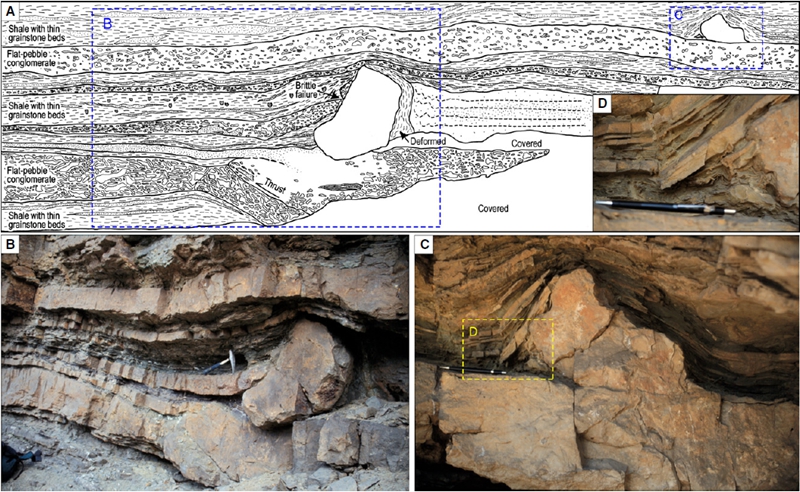Flat-pebble conglomerates (limestone breccias and conglomerates) (Fig. 1) are a common phenomenon in the Cambrian successions worldwide. They bear important geological implications that have attracted geologists for several decades. There are, however, still controversies on their origins, especially those of the breccias with abundant vertically orientated clasts. The Furongian (upper Cambrian) Chaomidian Formation of the North China Platform contains numerous levels of limestone breccias and conglomerates that provide an excellent example to look into their formative processes. These breccias and conglomerates have been the focus of study and discussion since the 1980s, but yet there is still no consensus with respect to their geneses. Recently, Van Loon and others argued that the vertically orientated clasts of the breccias developed by a number of simultaneous “fountains” on the paleo-seafloor; the “fountains” formed by upward-directed fluidized flows originated from the sediment underlying the brecciated limestones.
In order to understand the formative processes of flat-pebble conglomerate, Dr. CHEN Jitao from Nanjing Institute of Geology and Palaeontology, Chinese Academy of Sciences briefly overviewed and specifically discussed the hypothesis proposed by Van Loon et al. (2013). While the novel “fountain” hypothesis is not impossible, based on field evidences and theoretical considerations, however, it is most likely that the vertically orientated clasts resulted from their re-orientation by upward flow of thixotropically liquidized, uncemented argillaceous sediment that was interbedded with brecciated limestone fragments. Besides, the deformation processes most likely took place under shallow burial. Further investigations by experimental analysis and model simulation may help to delineate and clarify the formative processes of these unusual Cambrian breccias.
In addition, CHEN Jitao was invited by Prof. Paul Myrow from Colorado College as a co-corresponding author, to carry out the researches on some unusual soft-sediment deformation structures found in Rocky Mountain, western Colorado, including slide scarps, thrusted beds, irregular blocks and internally deformed beds (Figs 2 and 3). These features represent parts of beds that detached, moved up onto and some distances across, the laterally adjacent undisturbed bed surfaces. Deformation of thin intervals of mud on the ocean floor by moving blocks rules out the possibility of storm-induced deformation, as the mud was not eroded by high shear stresses that would accompany the extremely large forces required to produce and move the blocks. Finally, internally deformed beds are characterized by large blocks, fitted fabrics of highly irregular fragments, and contorted lamination, which represent heterogeneous deformation, such as brecciation and liquefaction. The deformation structures were produced by earthquakes linked to the reactivation of Mesoproterozoic, crustal-scale shear zones in the central Rockies during the Late Cambrian. Analysis of the deformation structures indicates very large body forces, and calculated earthquake-generated ground motion velocities of ~1.6 m/s. These correspond to moment magnitudes of ~7.0 or more and a Mercalli Intensity of X+. These are the only known magnitude estimates of Phanerozoic (other than Quaternary) large-intensity earthquakes for the Rocky Mountain region, and they are as large as, or larger than, previous estimates of Proterozoic earthquakes along these major shear zones of the central Rockies.
These studies were financially supported by the National Natural Science Foundation of China, and were recently published by Science China Earth Sciences and sedimentology.
Related information of these papers:
1. Chen, J., 2015. Origin of the Furongian limestone breccias in the North China Platform. Science China Earth Sciences 58, 770–775.
Fig. 1. Various limestone breccias and conglomerates in the Furongian Chaomidian Formation of the North China Platform. (a)-(b) Limestone conglomerate with imbricated clasts, indicating they were reworked by currents. (c)-(d) Limestone breccia containing undulatory platy clasts and abundant vertically orientated clasts that were most likely formed by soft-sediment deformation of limestone-marlstone alternations.
Fig. 2. Irregular blocks and relationships to underlying and overlying layers. (A) Two stacked blocks representing possible duplex structure. (B) An irregular block showing deep penetration into the underlying bed. (C) An irregular block with deformation of laterally adjacent grainstone and shale. (D) Close-up showing that some grainstone and shale beds were forced downward, and others forced upward (white arrows) during lateral movement of the block (yellow arrow).

Fig. 3. Thrusted bed and irregular blocks. (A) Line drawing showing heterogeneous deformation of laterally adjacent sediment around an irregular block (center). (B) Large irregular block on a thick bed, which slid across the upper surface and inserted into the overlying strata. Hammer is about 30 cm long. (C) Irregular block with flat base and irregular top, showing heterogeneous deformation of laterally adjacent sediment. (D) Close-up showing brittle failure of thin grainstone beds and ptygmatically folded grainstone dikes in shale above pencil cap.
Fig. 4. Schematic model for the formation of various deformation features in the Dotsero and Manitou formations. (A)–(E) Deformation at the sediment-water interface. (F)–(J) Deformation taking place under a thin layer of much-rich strata.
